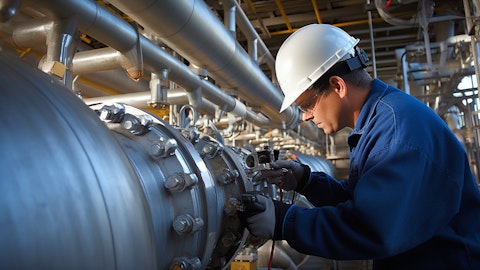We think that was one driver. The second thing that we know is a driver is the availability of compression experience and labor. I think our customer base was very happy and looking forward to outsource more to the industry because it’s expertise and labor that’s available in us that was not necessarily one pocket of experience they want to build for themselves. So with those factors, I think, being the primary drivers of the market, we think that the amount of horsepower that’s gone into the Permian has not been aligned with that 70-30 balance. We don’t know if it’s more 60-40, but that’s probably a fair estimate of what we think has happened in that part of the market. And as evidence of that, by the way, we know there’s more compression that is operated by the outsourced service providers like Archrock and certainly including Archrock in the midstream sector than there ever has been in the past.
So we think that the direction is clear. The numbers are not.
Josh Jayne: That’s great. Thank you. And maybe just one other question. Geographically, could you sort of walk around the areas outside of the Permian where you might expect to see growth. You mentioned the Rockies in your prepared remarks. I’m just curious how you see the other markets across the U.S. developing here, not only through the end of this year, but moving forward into ’25 and ’26.
BradleyChilders: The pockets where we’ve seen the most traction and growth recently and what we expect to see so in the future outside of the Permian include certainly the Rockies, South Texas and the Northeast. That’s where we’ve experienced the growth, and that’s where we believe we will see incremental growth. But I’m going to be clear, 60% of our growth in our CapEx is going into the Permian today and everything else is participating in the remainder. And so the Permian remains the market for growth and everything else is an incremental growth opportunity for us.
Josh Jayne: Great. Thank you very much.
BradleyChilders: Thank you.
Operator: [Operator Instructions] Our next question comes from Steve Ferazani from Sidoti. Your line is now open.
Steve Ferazani: Good afternoon, Brad, Doug. I wanted to ask about the continued strength in aftermarket. It’s multiple quarters over $45 million in revenue and now second out of four quarters where your margin is 23% or better. Multiple quarters ago, you talked about the strength coming from pent-up demand coming out of COVID and maintenance overdue. But you’re continuing to grow that business is up 8% year-over-year. Same type of demand patterns you’re seeing on the contract compression or anything different going on in Aftermarket?
BradleyChilders: Thanks for the question. The driver really of the revenue, but certainly the margin expansion that you’re seeing in AMS is due to a couple of things. Number one, the mix. So we’re seeing a higher amount of service work compared to just parts pull-through. And That’s certainly impacting the margin. And second, the team has done a great job of seeking higher margin work with customers. And then finally, I’m just going to point out that the market for labor is really tight today. And we have a tremendously talented workforce that is in high demand. We don’t necessarily see that abating. And I’m also going to just close with, however, it’s a notoriously difficult business to forecast. So with that caveat, we still are very bullish and ambitious of the value that we’re going to get from – through the AMS business segment in 2024.
Steve Ferazani: You noted how much of that is tied to the strength in your service personnel and your response times. How has it worked for you in terms of ability to retain labor and labor costs? Is it easier in what would be a weaker market in other ends of oil and gas right now?
BradleyChilders: Correctly, the answer is yes. This slight low that we’re seeing in natural gas production growth and in the market right now as everybody is getting ready for what is going to be a ramp in ’25 and beyond has given us an opportunity to stabilize and we’ve seen that in the labor pool a bit. That said, we still cannot get enough labor, more labor is going to equate some more work and growth in our AMS business, in particular. So we’re still fighting the good fight to bring in as much – bringing and train as much talent as we can. The market is really still looking for more.
Steve Ferazani: Great. Just a quick one on the fleet high-grading. What’s left in terms of make-ready on idle capacity? I know your maintenance CapEx was down again, I’m assuming it was produced make-ready and general asset sales. We at the latter stages on that?
BradleyChilders: We are. We’re really happy with the progress we need to standardize the fleets to improve our fleet competitiveness, fleet age. All of that was really critical before we invested in and added the technology into the fleet that we’ve added. But we still have a few pockets in some of the outlying basins that we would be willing to sell for the right price. But candidly, in the market that we’re in, we’re just as happy to continue to operate as we are to part with it. So it’s all going to be a function of the buyers appetite and assignment of value.
Steve Ferazani: Great. Thanks very much.
BradleyChilders: Thank you.
Operator: There are no more questions. Now I’d like to turn the call back over to Mr. Childers for final remarks.
Bradley Childers: Great. Thank you, everyone, for participating in our first quarter call. Archrock is in an enviable position and the market is strong. 2024 is off to a great start and I look forward to updating you on our progress next quarter. Thank you, everyone.
Operator: Thank you all for attending today’s call. We hope you have a wonderful day. You may now all disconnect.
Follow Archrock Inc. (NYSE:AROC)
Follow Archrock Inc. (NYSE:AROC)
Receive real-time insider trading and news alerts




